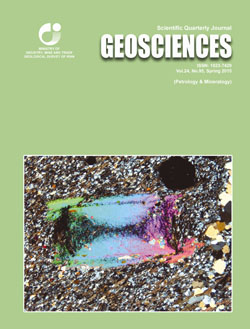Document Type : Original Research Paper
Authors
1 Associate Professor, Department of Geology, Faculty of Science, Urmia University, Urmia, Iran
2 M. Sc., Department of Geology, Faculty of Science, Urmia University, Urmia, Iran
3 Assistant Professor, Department of Geology, Faculty of Science, Urmia University, Urmia, Iran
Abstract
Gharali lateritic iron-rich deposit is located in 20 km of Boukan city, West Azarbayedjan province. Eight surveyed stratiform outcrops stretched into thedolomite and limestone of Ruteh Formationin this region. Based on mineralogy, the analysed samples indicate scattered, veinlet, acicular, replacement, spong, flow and cataclasic textures. The observed textures represents intense tectonic effects and non-residual origin.According to the chemical data, outcrops varies from iron-rich laterite to bearing ferritic bauxite, but in general the different diagrams put this ore deposit in a bauxite- laterite ore type. The results of geochemical data indicate enriched Fe, Al, and Ti and depletion Si, Ca, Na and K in ore deposits. REEs distribution pattern normalized to chondrite reveals weak differentiation of HREEs and LREEs with slightly enrichment of LREEs. The primary rock type has been considered to be a rich- iron mafic rocks (e.g. basaltic type). Following the removal of mobile elements, which have also resulted in increasing of Al2O3 andFe2O3, during alteration processes. The results show that clay minerals, Muscovite are not a suitable host for rare earth elements in the ore body. The results of chemical analyses and correlation coefficients show that neither rutile - anatase and nor clay minerals, muscovite, illite, and also Mn minerals play an important role in in hosting the REEs.The negatively correlated with Ti and Th (0.99) indicating lack of anatase titanium and thorium, and positive correlation of consentration between the Ti with Gd (0.91) shows that the consentration of rutile and anatase. Strong positive correlation of P-REEs indicate the role of secondary phosphate minerals consentration on rare earth elements except three elements such as Gd, Tb and Er in outcrops. The strong positive correlation of P with HREEs unravel phosphatic minerals role in enrichment of REEs except for three rare elements (Gd, Tb and Er) in outcrops.The Strong correlation between Gd, Tb and Er indicates their concentration with neomorphic minerals and their resistance nature against alteration and weathering are two main reasons for their difference distribution compared to other REEs inthese deposits.
Keywords

